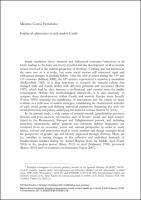Chapter Keeping up appearances in early modern Castile
| dc.contributor.author | García Fernández, Máximo | |
| dc.date.accessioned | 2022-06-01T12:29:36Z | |
| dc.date.available | 2022-06-01T12:29:36Z | |
| dc.date.issued | 2022 | |
| dc.identifier | ONIX_20220601_9788855185653_790 | |
| dc.identifier.uri | https://library.oapen.org/handle/20.500.12657/56606 | |
| dc.description.abstract | Social emulation stimulated the demand for clothing with the rapid generalisation of certain types of dress in given social circles. Beginning with this birth of fashion in the 16th century, the 18th century witnessed a revolution in consumption. Material culture had a public projection, and appearance and luxury became variables of civilization. In this methodological framework, and using tutorship accounts and inventories (from the Renaissance and Enlightened periods, and from rural and courtesan contexts), this paper aims to examine cloths and accessories that made a difference, with consideration to age, and gender. The evolution of this process in Castile is compared with that in other western European countries in terms of innovation, availability, intercultural contacts and social aspirations. | |
| dc.language | English | |
| dc.relation.ispartofseries | Datini Studies in Economic History | |
| dc.subject.other | Fashion | |
| dc.subject.other | Appearances | |
| dc.subject.other | Consumption | |
| dc.subject.other | Castile | |
| dc.title | Chapter Keeping up appearances in early modern Castile | |
| dc.type | chapter | |
| oapen.identifier.doi | 10.36253/978-88-5518-565-3.18 | |
| oapen.relation.isPublishedBy | bf65d21a-78e5-4ba2-983a-dbfa90962870 | |
| oapen.relation.isbn | 9788855185653 | |
| oapen.series.number | 2 | |
| oapen.pages | 22 | |
| oapen.place.publication | Florence |

